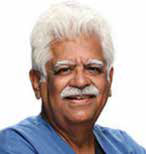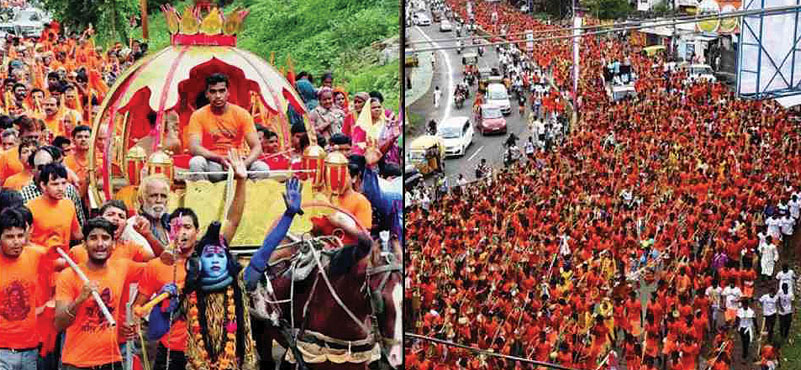It is in these two holy months of Shravan that we worship snakes. It is the time when you see the mass movement of Kanwariyas, worshipping Lord Shiva.
It is so common in India to see the ancient stand adjacent to the new! Nothing bears this out more than the month of Shravan in the Indian calendar. It corresponds to July-August in the Gregorian calendar and is possibly one of the amazingly auspicious occasions in the subcontinent. This year, the month of Shravan will last for two months, beginning from the 4th of July till the end of August. The reason for this is the interlude of an inauspicious period called Adhik Maas from July 18 to August 16. Adhik Maas comes every 3 years, and is a period when marriages and celebrations are postponed. However, the arrival of the southwest monsoon during this month is greeted with joy, as it displaces the fiery heat of the summer. Nowhere on the entire planet is rain so welcomed!
On an esoteric plane, Lord Shiva was reunited with his wife Sati, who after her self-immolation, incarnated as Mata Parvati, again in the month of Shravan. Lord Shiva and Mata Parvati, with their children, leave their celestial abode of Mount Kailash and travel to Earth to reside in Bhu Loka. Krishna Janmashtami or the birth of Krishna falls on the eighth day of the full moon. The annual Kanwar Yatra takes place during the Shravan. Nag Panchami is celebrated on the fifth day after Shravana Amavasya. We worship snakes on that day and put out bowls of milk for them to imbibe, yet we do not hesitate to kill, even when the snake is not a threat. This entirely irrational behavior is born out of the fear of being harmed.
Why are snakes worshipped? What is the mythology behind it? It is so rich and fascinating!
There are two kinds of serpents – Sarpa and Naga. In Sanskrit, sarpum or sarpa means a snake. Naga or nagam too means a snake, and both terms are used as synonyms. In mythology, Nagas are semi-divine, can assume any form, and inhabit a world of their own. Other semi-divine beings are Kinnaras, Gandharvas, and Yakshas. Nagas are wealthy and live in palatial houses in an underground region called Patala. They are associated with the devas or gods. Nagas can have a form that is half man and half snake. Vasuki, a Naga and in fact the king of the Nagas and is known as Nagraja, is wrapped around the neck of Shiva. Sarpas are not divine, cannot change their form, are associated with demons, and live on earth as they do not have a world of their own. Takshaka is the king of the Sarpas.
Naga worship is the worship of the cobra. There are idols devoted to Nagas in temples, The snake sheds its skin and thus remains youthful. It has inherent qualities of immortality, knowledge, and strength.
Sheshnaga or Adishesha (the foremost among snakes) or Ananta (meaning endless as he remains in existence even at the end of the Kalpa, when the whole universe is destroyed) is the king of all nagas. The Mahabharata says that Sheshnaga was the eldest child of Rishi Kashyap and his wife Kadru, the daughter of Daksha. Kadru is the mother of thousands of snakes, a large number of which are vindictive and harmful. Sheshnaga had a different temperament, and disgusted by the barbaric attacks of his brothers, left his family and began penances and austerities. Brahma, who is the father of Daksha was impressed with his austerities and told him to ask for a boon. Sheshnag asked that he be allowed to find joy and solace in dharma, his austerities, and in tranquillity. Brahma recognized the sterling qualities of Sheshnag and made a request. He asked Sheshnag to hold the earth so it remained stable. Sheshnag then entered the earth which made a path for him, and began to live underground, holding the earth on his hoods. The Puranas say that it is on the many hoods of Sheshnaga that the universe rests. It is he who holds the planets in their position in it. Lord Vishnu rests on the coils of Sheshnaga, Resting on Sheshnaga is Kurma, the tortoise form of Vishnu. Movements of Kurma cause Sheshnaga to move and that’s when earthquakes happen. When he uncoils, time moves forwards, and creation takes place. When he coils back, the universe ceases to exist.



Vasuki is known as Nagraja and it is Vasuki who is coiled around the neck of Shiva. Being the King of all Nagas allows Vasuki to wear the Nagamani jewel on his head. When the devas and asuras banded together to churn the Ocean of Milk a churning post and a churning rope were needed. Garuda was sent to bring Mount Meru which he did easily. This was placed on Kurma. Vasuki volunteered to be the churning rope. Garuda was sent by Vishnu to bring Vasuki, and both are sworn enemies. This was put aside temporarily and Vasuki allowed Garuda to hold him in his beak. When Garuda thus took flight, the unending length of Vasuki prevented him from taking to the air. Garuda dropped Vasuki and flew back to Vishnu, admitting his failure. Vishnu then extended his hand, and Vasuki coiled himself around the Lord’s wrist as a bracelet!
Mansa Devi is the sister of Vasuki and the wife of Rishi Jaratkaru. She is seen sitting on a lotus and has snakes around and on her. She holds a child in her lap. She is worshipped to prevent snake bites and to cure snakebites. She is the goddess of fertility as signified by the child on her lap. Her son is Astika.
Rishi Jaratkaru, as yet unmarried, came across the souls of his ancestors who were hanging precariously over a precipice and were prevented from falling by blades of grass. His inquiries revealed that they were his ancestors and their route to heaven was blocked by the absence of his heir as he was still unmarried. Jaratkaru decided that he must marry, but his bride must have the same name as his! He encountered Vasuki who offered him a bride – his sister Mansa who also bore the name Jaratkaru. And so the marriage was solemnized.
One day Rishi Jaratkaru fell asleep resting his head in the lap of Mansa Devi. Dusk was falling, and the prayers of the Rishi were due. Mansa was in a dilemma – if she did not wake her husband he would miss his prayers, and if she shook him awake, almost certainly she would be the object of his wrath. She felt prayers were more in accordance with the life of a Rishi and she woke him. Rishi Jaratkaru was so full of wrath that he declared he was leaving her! When she pleaded with him, he informed her that she was pregnant, but her son would be a genius, devoted to dharma and prayers. She should name him Astika.
A snake called Takshaka bit Parikshit, the son of Arjuna, when he had inherited the kingdom of the latter. The son of Parikshit, Janamejaya was incensed. He decided that all snakes were to be exterminated. The mass killing of all snakes, called Sarpa Satra was in the form of a yagna, including Takshaka. The power of the yagna was so strong that all snakes would be drawn to the sacred fire and be devoured in its flames. The world would be free of snakes! It was Astika, who was still a boy; he appeared during the yagna and persuaded him to cease his gruesome mass execution and thus saved the life of Takshaka. That day is Shukla Paksha Panchami in the month of Shravan and is celebrated as Nag Panchami. Women offer flowers and pour milk into ant hills or snake holes. Incense sticks are placed around these.
Kaliya is well known! A poisonous snake, who was afraid of Garuda, was forced to move to the Yamuna River in Vrindavan from his native Ramanaka Dwipa. Vrindavan because Garuda could not enter Vrindavan. Kaliya was so poisonous that he had contaminated the river with his poison and nothing survived. Krishna and his friends were playing by the river and the ball fell into it. The Lord waded into the river to retrieve it and Kaliya appeared with his many hoods and spewing poison. The Lord fought the snake and emerged from the river dancing on the hoods of Kaliya.
In India, Nagas are honored. Nagraj and Nagamani are names that are still used. Nagpur is of course well known, possibly for the snakes that were once prevalent there. Another place is Nagapattinam which is an important town in Tamil Nadu. Urban India has driven away its snakes, but in our villages and smaller towns, the traditions of snake worship continue to thrive.
ABOUT THE AUTHOR
 Dr H N Bajaj is a spine surgeon, an author, an avid gardener, and maintains a keen interest in religious mythology. He heads a foundation called Bhikteshwar Foundation which is engaged in constructing a medical centre in rural Rajasthan.
Dr H N Bajaj is a spine surgeon, an author, an avid gardener, and maintains a keen interest in religious mythology. He heads a foundation called Bhikteshwar Foundation which is engaged in constructing a medical centre in rural Rajasthan.




































